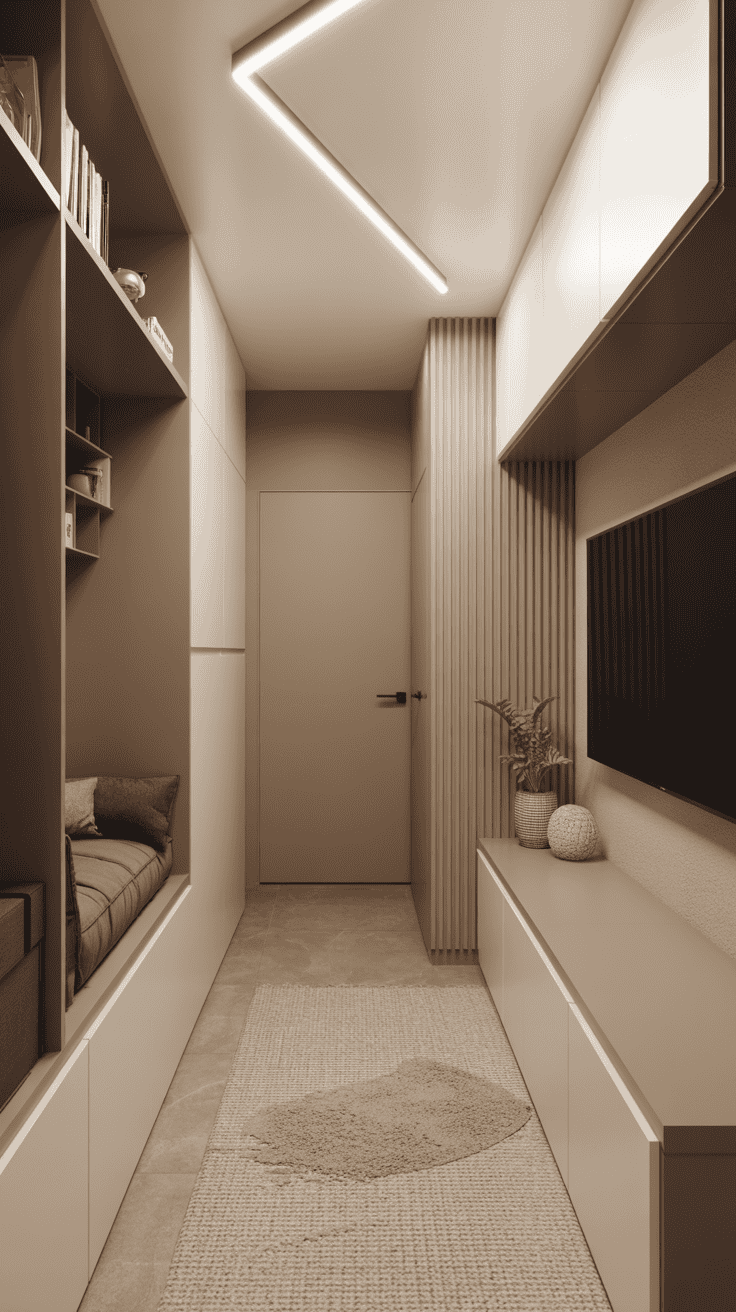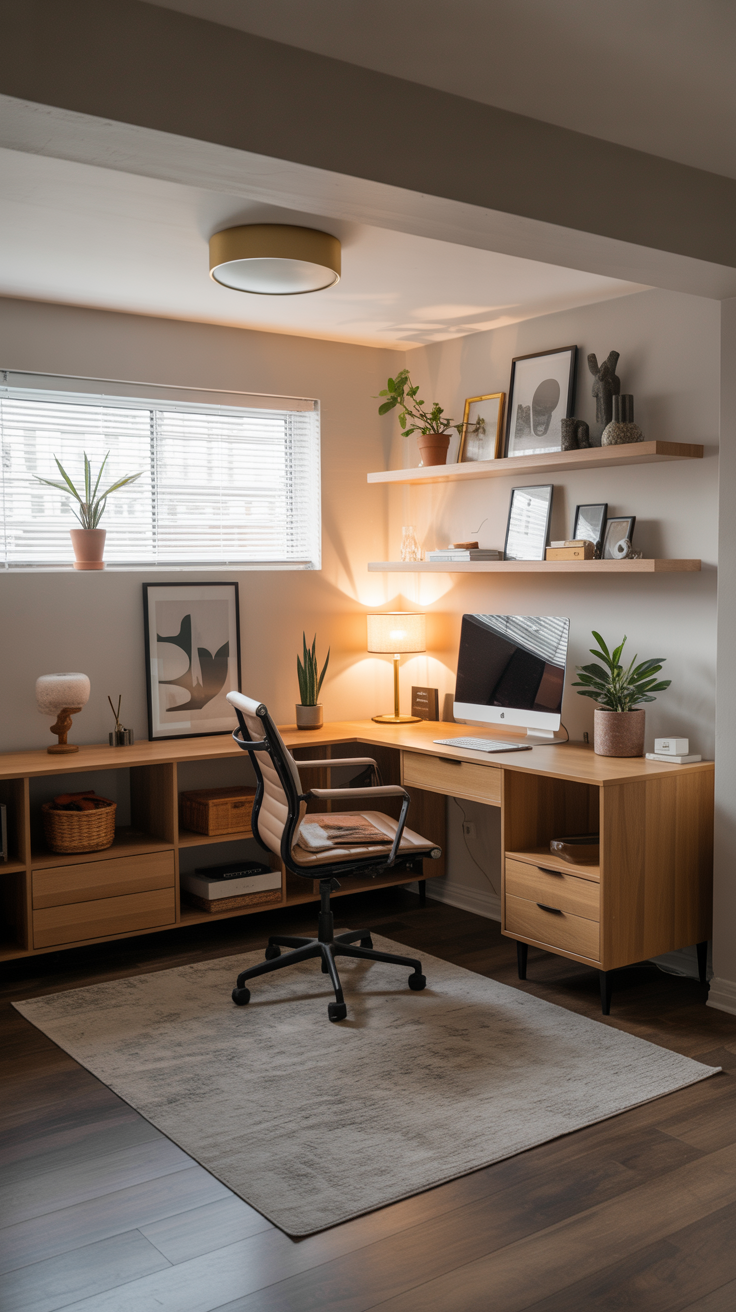This post shows Genius Narrow Basement Layout Ideas!
You know that awkward moment when you stare at your narrow basement and wonder if you accidentally bought a house designed for hobbits? Trust me, I’ve been there. That cramped underground space might look like a lost cause, but here’s the thing – narrow basements are actually goldmines waiting to happen.
I spent months scratching my head over my own skinny basement before I figured out the secret sauce. Turns out, working with limited width isn’t a curse – it’s an opportunity to get seriously creative. Ready to transform that underground hallway into something that’ll make your friends jealous? Let’s talk about how to squeeze every ounce of potential from your narrow space.
Think Vertical: Your Ceiling is Your Best Friend
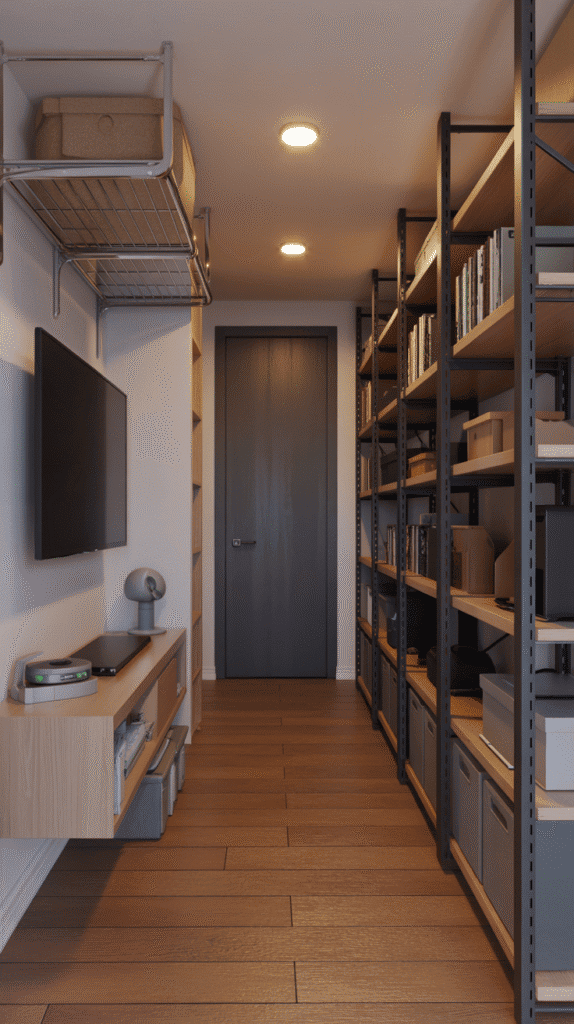
Here’s what most people get wrong about narrow basements – they focus on the floor when they should be looking up. Your vertical space is pure gold, and I’m about to show you how to mine it properly.
Wall-mounted storage systems work absolute magic in tight spaces. I’m talking about those modular shelving units that go from floor to ceiling. You can customize them however you want, and they don’t eat up precious floor space. Mount your TV on the wall instead of using a bulky entertainment center. Trust me, your future self will thank you when you’re not bumping into furniture every five seconds.
Don’t forget about overhead storage solutions either. Those ceiling-mounted racks are perfect for seasonal stuff you don’t need constantly. Christmas decorations, camping gear, old photo albums – all that clutter can live above your head instead of crowding your living space.
Pro tip: Use the space under your stairs if you’ve got them. That weird triangular area everyone ignores? Perfect spot for a reading nook or mini office. Ever seen those Harry Potter under-stair setups? Yeah, minus the child abuse, those are actually brilliant space savers 🙂
Strategic Zoning: Make Every Corner Count
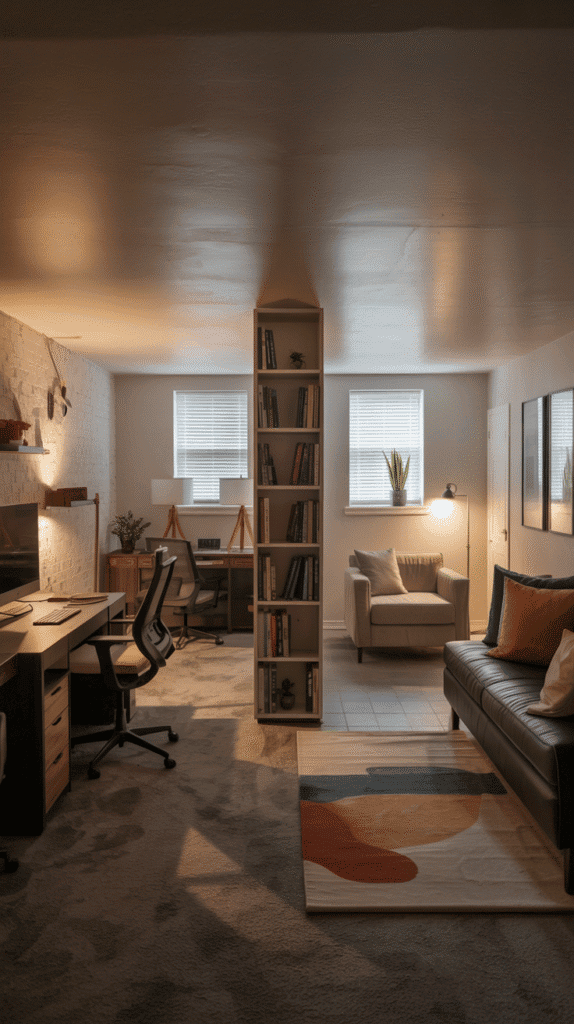
Narrow doesn’t mean you can’t have multiple functions – you just need to be smarter about how you divide things up. Zone planning is your secret weapon for making a skinny basement feel like a proper multi-room space.
I learned this the hard way after trying to cram everything into one open area. Total disaster. Now I create distinct zones using furniture placement, area rugs, and clever lighting. You don’t need actual walls to separate a workout area from a entertainment zone.
Here’s what works: Use bookcases as room dividers. They give you storage AND create visual separation between different areas. A tall bookshelf can easily separate your home office from your relaxation space without making things feel choppy.
Lighting plays a huge role in zone definition too. Use different types of lighting for different activities. Bright task lighting for your work area, softer ambient lighting for your chill zone. It’s amazing how much this simple trick can make spaces feel distinct and purposeful.
Color coding helps too. I use different color schemes for different zones – cool blues for the work area, warm earth tones for the lounge space. It’s like having separate rooms without the actual walls eating up your square footage.
Multi-Functional Furniture: The Space-Saving Champions
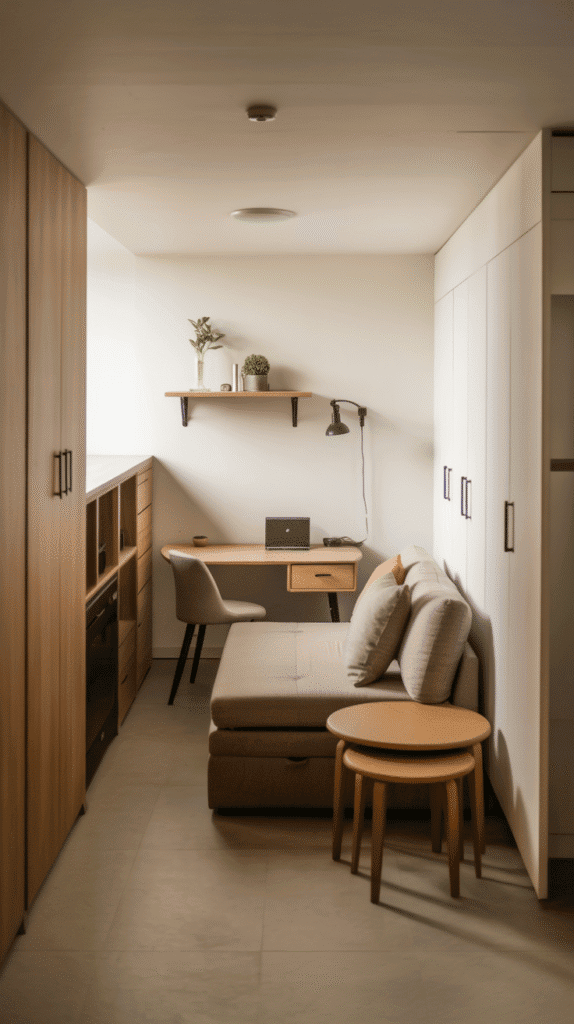
If your furniture only does one job, you’re wasting space. Period. Multi-functional pieces are the MVP of narrow basement design, and I’ve got some game-changing suggestions for you.
Storage ottomans are absolute lifesavers. They give you seating, a footrest, AND hidden storage all in one compact package. I use mine to store throw blankets, board games, and all those random cables that seem to multiply when you’re not looking.
Sofa beds might sound cliché, but modern ones are actually pretty comfortable. Perfect for when guests visit, and they don’t take up any extra floor space when you’re using them as regular seating. Just make sure you get one with built-in storage underneath.
Nesting tables are brilliant for narrow spaces. When you need extra surface area, pull them out. When you don’t, they tuck away neatly. I keep mine nested most of the time and only separate them when I’m entertaining.
Consider a fold-down desk if you need workspace but don’t want it dominating your basement. These wall-mounted beauties fold flat against the wall when not in use. Perfect for paying bills or working from home without sacrificing your entertainment space.
Don’t overlook bar-height tables with storage. They take up less visual space than regular dining tables, and most come with shelves or cabinets built right in. Plus, you can use bar stools that tuck completely underneath.
Lighting Magic: Brighten Up That Cave
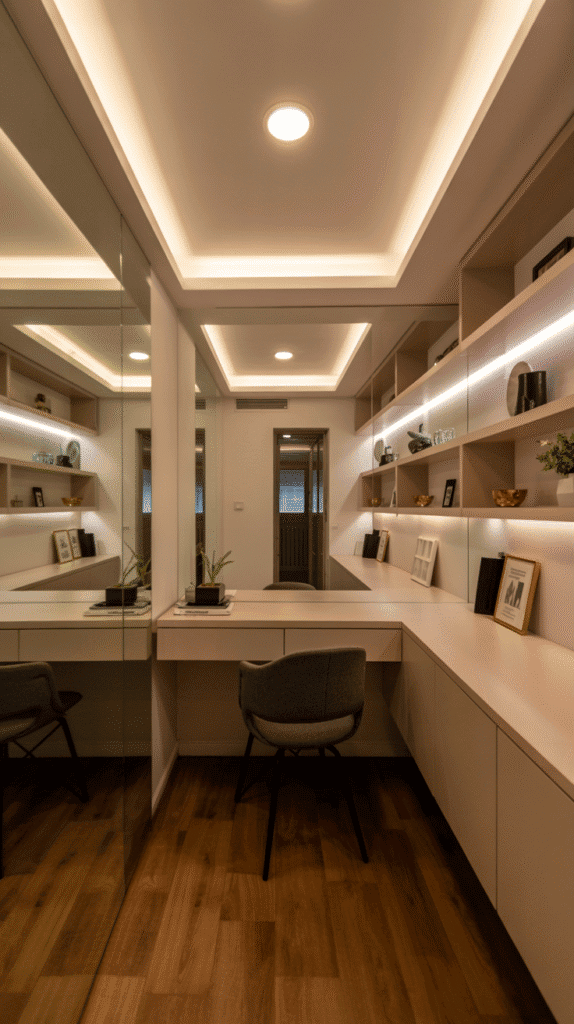
Basement lighting can make or break your whole vibe. Poor lighting makes even spacious basements feel like dungeons, so imagine what it does to narrow ones. But here’s the good news – proper lighting can actually make your space feel wider than it really is.
Recessed lighting is your best friend for low ceilings. Those bulky fixtures that hang down? They’ll make your narrow basement feel like a submarine. Stick with flush-mount or recessed options that don’t steal precious headroom.
Layer your lighting like a pro. You need three types: ambient (general lighting), task (focused lighting for specific activities), and accent (decorative lighting that adds mood). I use LED strip lights under shelves and behind the TV for accent lighting – creates this cool floating effect that makes walls seem further apart.
Mirrors and metallic surfaces reflect light around the room, making everything feel more open. I hung a large mirror on one of the long walls, and honestly, it almost doubled the perceived width of my space. Strategic mirror placement is like having a magic wand for small spaces.
Natural light is tricky in basements, but if you’ve got any windows, maximize them. Keep treatments minimal – heavy curtains will just make things feel more closed in. If you don’t have windows, consider those fake window light boxes. Sounds gimmicky, but they actually work pretty well.
Smart Storage Solutions That Don’t Suck
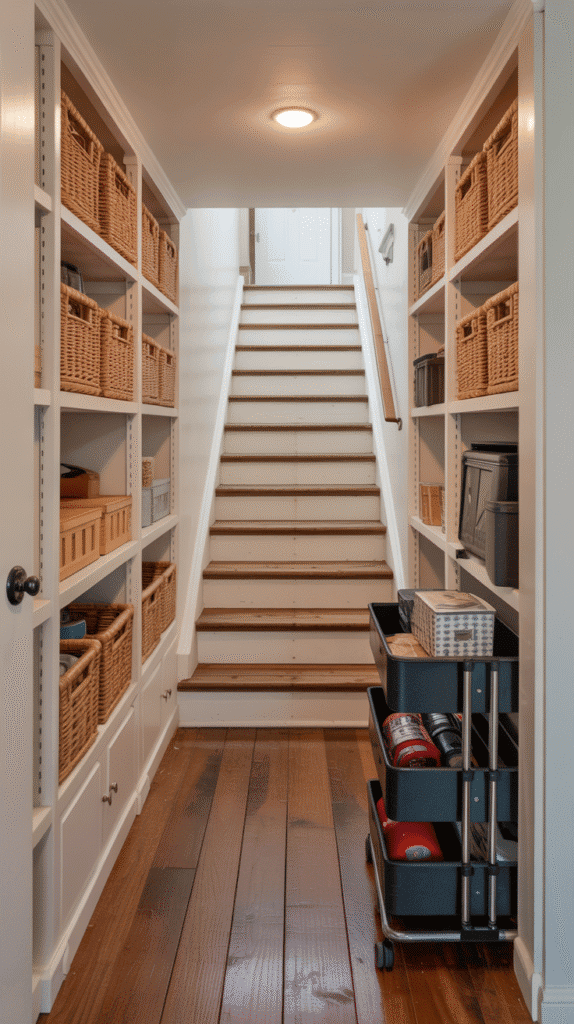
Storage in narrow basements requires next-level creativity. Forget everything you know about traditional storage – we’re going guerrilla style here.
Built-in storage beats freestanding furniture every single time in narrow spaces. Custom shelving that fits perfectly between your walls doesn’t waste a single inch. If built-ins aren’t in your budget, at least look for furniture that fits flush against walls without gaps.
Vacuum storage bags are game-changers for seasonal items. Your winter coats and extra bedding can shrink down to nothing, freeing up tons of closet space. I was skeptical at first, but these things seriously work.
Behind-the-door storage is criminally underutilized. Those over-the-door shoe organizers work for way more than shoes. I use them for cleaning supplies, craft materials, and random household stuff. Every door in your basement should be working double duty.
Under-furniture storage is another goldmine. Storage boxes that slide under sofas and beds keep things organized without taking up extra floor space. Just make sure you label everything – there’s nothing worse than digging through unmarked boxes looking for something specific.
Think about dead spaces too. That gap between your water heater and the wall? Perfect spot for a narrow rolling cart. The space behind your furnace? Ideal for long-term storage of stuff you rarely need.
Color Psychology: Paint Your Way to More Space

Colors can literally change how big your basement feels. The right paint job is like optical illusion magic, and it’s probably the cheapest renovation trick you’ll ever use.
Light colors reflect more light and make spaces feel larger – this isn’t groundbreaking news. But here’s what most people don’t know: painting your ceiling the same light color as your walls eliminates visual boundaries and makes the whole space feel more open. I painted everything in my basement a soft warm white, and the difference was incredible.
Cool colors recede while warm colors advance. In a narrow space, you want those long walls to recede, so consider cool blues or greens on the sides and warmer tones on the shorter end walls. This creates visual depth and makes your basement feel less like a hallway.
Avoid dark colors on large surfaces – they’ll make your space feel like a cave. Save darker colors for accent pieces and accessories. A dark accent wall can actually work in narrow spaces, but only on one of the shorter walls, never the long sides.
Don’t forget about your floor color either. Light flooring makes the whole space feel more open, while dark floors can make everything feel cramped. If you’re stuck with dark concrete, consider light-colored area rugs to break up all that visual weight.
Tech Integration: Smart Solutions for Tight Spaces
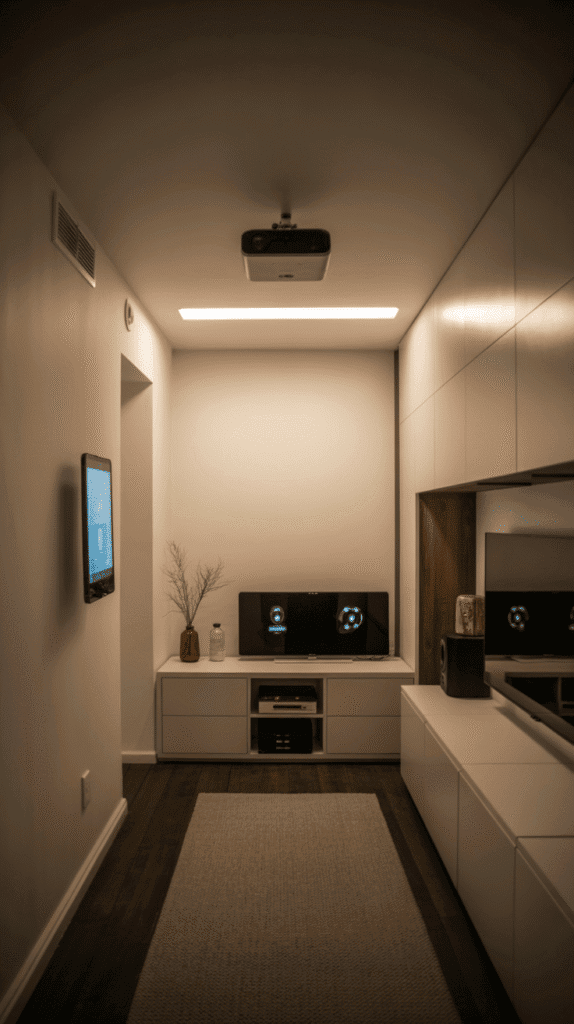
Modern technology can solve a lot of narrow basement problems. Smart home tech isn’t just cool gadgets – it’s practical space-saving solutions that actually make your life easier.
Wall-mounted tablets can replace multiple devices and save counter space. I use mine for music, smart home controls, and even streaming shows while I’m working out. No more cluttered surfaces with remote controls and charging cables everywhere.
Smart lighting systems let you adjust brightness and color temperature throughout the day. Brighter, cooler light during work hours, warmer, dimmer light for relaxation. It’s like having different rooms without actually changing anything physical.
Wireless charging stations built into furniture eliminate cable clutter. Those surface-mounted charging pads you can install in desks and side tables are total game-changers. No more hunting for charging cables or dealing with cord tangles.
Voice assistants are perfect for narrow spaces because they don’t take up any room at all. Control your lighting, music, and smart home devices without needing physical switches and controls taking up wall space.
Projectors beat big-screen TVs in narrow basements. You get a huge viewing experience without a massive piece of furniture dominating your space. Modern projectors are surprisingly good, and some are small enough to mount on the ceiling out of the way.
Conclusion: Your Narrow Basement’s Bright Future
Your narrow basement doesn’t have to be the awkward stepchild of your house anymore. With some strategic thinking and creative solutions, you can transform that skinny space into something genuinely awesome.
The key is working with your limitations instead of fighting them. Embrace the vertical space, get smart about storage, and don’t be afraid to think outside the box. Every narrow basement challenge has a solution – you just need to get creative about finding it.
Remember, some of the coolest spaces I’ve seen were born from serious constraints. Your narrow basement might just become your favorite room in the house. And hey, at least your friends will never complain about not having enough elbow room when they’re hanging out down there – they’ll be too busy being impressed by your space-maximizing genius 🙂

